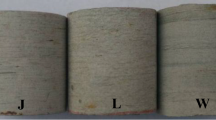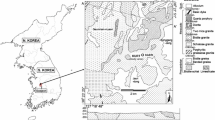Abstract
Given that the rock mass classifications of weak rocks observed in tunnels are evaluated only as ‘poor rock mass’ or grades IV–V using existing rock mass classification methods, a new scheme is needed that would better distinguish the various geological properties of weak rocks. In this study, geological and engineering properties of weak rocks were classified based on the analysis results of a total of 55 faces in a tunnel that passes through a fault zone in southeastern South Korea. Geological observations, point load tests, and Schmidt hammer tests were conducted to analyze the properties of the weak rocks. Through this analysis, the weak rocks were classified into two weathering types: ‘disintegrated rocks’ and ‘decomposed rocks’. This division is based on the tectonic mechanisms and parameters necessary to determine the engineering geological properties of individual rock-weathering types according to their geological properties. The ‘disintegrated rocks’ have been physically weathered by brittle deformation and are classified into three subtypes using the rock quality designation (RQD) and joint set number (Jn), which can characterize the discontinuity properties of the rocks. Point load tests were conducted on these individual subtypes to calculate the point load index (Is(50)). The resultant values are clearly related to the assigned three subtypes. The ‘decomposed rocks’ have been chemically weathered by ductile deformation and are classified into five subtypes based on the results of Schmidt hammer tests conducted on faces and Is(50) values calculated using the average of the Schmidt hammer values. The geological properties of the individual subtypes of the ‘disintegrated rocks’ and ‘decomposed rocks’ are clearly related to their engineering properties. Based on these results, rock mass classification diagrams are proposed that can be simply and easily applied to weak rocks.














Similar content being viewed by others
References
Amin M, Kassim A (2000) Description and classification of filled joint in granite-an approach. Geol Soc Malaysia Bull 44:45–54
Arikan F, Aydin N (2012) Influence of weathering on the engineering properties of dacites in northeastern Turkey. Int Scholarly Research Notices Soil Science 2012:1–15
Barton N, Lien R, Lunde J (1974) Engineering classification of rock masses for the design of tunnel support. Rock Mech 6:189–236
Bieniawski ZT (1973) Engineering classification of jointed rock masses. Transactions of the RSA Institution of Civil Eng 15(12):335–344
Bieniawski, ZT (1979) The geomechanics classification in rock engineering applications. In: Proceedings of the 4th Congress of the International Society for Rock Mechanics, vol. 2, ISRM, Montreux, pp 41–48
Bieniawski ZT (1984) Rock mechanics design in mining and tunneling. A.A. Balkema, Rotterdam
Bieniawski ZT (1989) Engineering rock mass classification. John Wiley, New York
Bieniawski ZT (1993) Classification of rock masses for engineering: the RMR system and future trend. In: Hudson JA (ed) Comprehensive rock engineering, vol 3. Pergamon Press, New York, pp 553–574
British Standards Institution (1981b) BS 5930:1981: code of practice for site investigations (formerly CP 2001). British Standards Institution, London
Broch E (1983) Estimation of strength anisotropy using the point-load test. Int J Rock Mech Min Sci & Geomech Abstr 20(4):181–187
Ceryan S (2008) New chemical weathering indices for estimating engineering properties of rocks: a case study from kurtun granodiorite, NE Turkey. Turkish J Earth Sci 17:187–207
Ceryan S (2011) Estimating of the durability and weathering state of rock materials using chemical weathering indices based on cation packing value: A case study. In: Proceedings of 11th International Multidisciplinary Scientific Geoconference, vol. 1, SGEM 2011, Bulgaria, pp 437–444
Choi JH, Kim YS, Choi SJ (2015a) Identification of a suspected quaternary fault in eastern Korea: proposal for a paleoseismic research procedure for the mapping of active faults in Korea. J Asian Earth Sci 113:897–908
Choi JH, Kim YS, Gwon SH, Paul E, Sowreh R, Kim TH, Lim SB (2015b) Characteristics of large-scale fault zone and quaternary fault movement in Maegok-dong, Ulsan. J Eng Geol 25(4):485–498
Chough SK, Sohn YK (2010) Tectonic and sedimentary evolution of a cretaceous continental arcbackarc system in the Korean peninsula: new view. Earth-Sci Reviews 101:225–249
Chough SK, Kwon ST, Ree JH, Choi DK (2000) Tectonic and sedimentary evolution of the Korean peninsula: a review and new view. Earth-Sci Reviews 52:175–235
Davis GH, Reynolds SJ (1996) Structural geology of rock and regions. Wiley, Hoboken
Dearman WR (1976) Weathering classification in the characterisation of rock: a revision. Bull Int Assoc Eng Geol 13:123–127
Dearman WR (1986) State of weathering: the search for a rational approach. Ln: HAWKINS AB (Ed) site investigation practice: assessing BS5930, geological society London. Eng Geol Spec Publication 2:132–142
Deere DU (1963) Technical description of rock cores for engineering purposes. Int Soc Rock Mech 1(1):16–22
Fossen H (2010) Structural geology. Cambridge University Press, Cambridge
Franklin JA (1970) Observations and tests for engineering description and mapping of rocks. Proc 4th Congress ISRM 1(1-3):1-6
Gokceoglu C, Aksoy H (2000) New approaches to the characterization of clay-bearing, densely jointed and weak rock masses. Eng Geol 58:1–23
González de Vallejo LI (1983) A new rock classification system for underground assessment using surface data. Engineering geology and underground construction. In: Proceedings International Association for Engineering Geology Symposium, Lisbon vol. 12, pp 85–94
Hencher SR, Martin PR (1982) The description and classification of weathered rocks in Hong Kong for engineering purposes. In: Proceedings of 7th Southeast Asian Geotechnical Conference, Hong Kong, pp 125–142
Hoek E, Brown ET (1997) Practical estimates of rock mass strength. Rock Mech Min Sci 34(8):1165–1186
Hoek E, Wood D, Shah S (1992) A modified Hoek-Brown failure criterion for jointed rock masses. In: Proceedings of the International ISRM Symposium on Rock Characterization, Eurock 92, London, pp 209–214
Hoek E, Marinos P, Benissi M (1998) Applicability of the geological strength index(GSI) classification for very weak and sheared rock masses. The case of the Athens schist formation. Bull Eng Geol Environ 57:151–160
International Society Rock Mechanics (1981) Suggested methods for determining hardness and abrasiveness of rocks. In: Brown ET (ed) Rock characterization, testing and monitoring: ISRM suggested methods. Pergamon, Oxford
International Society Rock Mechanics (1985) Suggested method for determining point-load strength. Rock Mech Min Sci 22:53–60
Irfan TY (1996) Mineralogy and fabric characterization and classification of weathered granitic rocks in Hong Kong. In: Geo Special Project Report No. SPR 3/94, Geotech Eng Office, Hong Kong, p 158
Irfan TY, Dearman WR (1978) Engineering classification and index properties of a weathered granite. Bull Int Assoc Eng Geol 17:79–90
Irfan TY, Powell GE (1985) Engineering geological investigations for pile foundations on a deeply weathered granitic rock in Hong Kong. Bull Int Assoc Eng Geol 32:67–80
Karpuz C, Pasamehmetoğlu AG (1997) Field characterisation of weathered Ankara andesites. Eng Geol 46:1–17
Kim YS, Park JY (2006) Cenozoic deformation history of the area around Yangnam-Yangbuk, SE Korea and its tectonic significance. J Asian Earth Sci 26:1–20
Lee JB, Chang CD (2009) Slip tendency of quaternary faults in southeast Korea under current state of stress. Geosci J 13(4):353–361
Lee SG, De Freitas MH (1988) Quantitative definition of highly weathered granite using slake durability test. Geotech 38(4):635–640
Lee SG, De Freitas MH (1989) A revision of the description and classification of weathered granite and its application to granites in Korea. J Eng Geol 22:31–48
Little AL (1969) The engineering classification of residual tropical soils. In: Proceedings of the 7th International Conference on Soil Mech and Foundation Eng, Mexico, vol. 1, pp 1–10
Marinos P, Hoek E (2001) Estimating the geotechnical properties of heterogeneous rock masses such as flysch. Bull Eng Geol Environ 60:85–92
Marinos V, Marinos P, Hoek E (2005) The geological strength index: applications and limitations. Bull Eng Geol Environ 64:55–65
Martin RP, Hencher SR (1986) Principles for description and classification of weathered rock for engineering purposes. Eng Geol Spec Publication 2, Geological Society, pp 299–308
Matula M (1981) Rock and soil description and classification for engineering geological mapping report by the IAEG commission on engineering geological mapping. Bull Int Assoc Eng Geol 24:235–274
Nickmann M, Spaun G, Thuro K (2006) Engineering geological classification of weak rocks. Bull Int Assoc Eng Geol 32:67–80
Norwegian Rock Mechanics Group (2000) Engineering geology and rock engineering. In: Handbook No. 2. Norwegian Rock and Soil Engineering Association, p 250
Palmström A (1995a) RMi – A Rock mass characterization system for rock engineering purposes. Ph.D thesis University of Oslo, Norway
Palmström A (1995b) Characterizing the strength of rock masses for use in design of underground structures. In: Conference of Design and Construction of Underground Structures. CSMRS, New Delhi, pp 43–52
Palmström A, Stille H (2007) Ground behaviour and rock engineering tools for underground excavations. Tunn Undergr Sp Tech 22:363–376
Park YD, Yoon HD (1968) Explanatory text of the geological map of Ulsan sheet. Geological survey of Korea (In Korean)
Riedmüller G, Schubert W (1999) Critical comments on quantitative rock mass classifications. Geotechnique Felsbau 17(3):164–167
Santi PM (2006) Field methods for weak rock for engineering. Geol Soc Am Bull 12(1):1–11
Santi PM, Doyle BC (1997) The locations and engineering characteristics of weak rock in the U.S. In: Santi PM, Shakoor A (eds) Characterization of weak and weathered rock masses. Assoc Engn Geologist, Denver, pp 1–22
Singh RN, Gahrooee DR (1989) Application of rock mass weakening coefficient for stability assessment of slopes in heavily jointed rock masses. Int J Surf Min Reclam Environ 3:207–219
Singh B, Goel RK (1999) Rock mass classification. Elsevier, Amsterdam
Son M, Song CW, Kim MC, Cheon Y, Jung S, Cho H, Kim HG, Kim JS, Sohn YK (2013) Miocene crustal deformation, basin development, and tectonic implication in the southeastern Korean peninsula. J Geol Soc Korea 49(1):93–118 (in Korean)
Stille H, Palmström A (2003) Classification as a tool in rock engineering. Tunn Undergr Sp Tech 18:331–345
Stille H, Palmström A (2008) Ground behaviour and rock mass composition in underground excavations. Tunn Undergr Sp Tech 23:46–64
Tsoutrelis CE, Exadatylos GE, Kapenis AP (1990) Study of the rock mass discontinuity system using photoanalysis. In: Rossmanith (ed) Proceedings of the symposium on mechanics of jointed and faulted rock, Rottetdam, pp 103–112
Unal E (1996) Modified rock mass classification: M-RMR system, milestones in rock engineering, The Bieniawski’s Jubilee Collection. AA Balkema, Rotterdam, pp 203–223
Unal E, Ozkan I (1990) Determination of classification parameters for clay-bearing and stratified rock masses. In: Proceedings of the 9th International Conference on Ground Control in Mining, West Virginia University, Morgantown, pp 250–259
Wittke N, Louis C (1969) Several quick tests for determining the mechanical character of rocks. Geotechnical Colloq, Toulouse
Yoon SH, Chough SK (1995) Regional strike slip in the eastern continental margin of Korea and its tectonic implications for the evolution of Ulleung basin, East Sea(sea of Japan). The Geol Soc Am Bull 107(1):83–97
Acknowledgments
This research was supported by a grant from the Construction Technology Research Program funded by the Ministry of Land, Infrastructure and Transport of the Korean government (No. 15SCIP-C069312-03).
Author information
Authors and Affiliations
Corresponding author
Rights and permissions
About this article
Cite this article
Yun, HS., Seo, YS. Classification of geological and engineering properties in weak rock: a case study of a tunnel in a fault zone in southeastern Korea. Bull Eng Geol Environ 78, 445–458 (2019). https://doi.org/10.1007/s10064-017-1156-7
Received:
Accepted:
Published:
Issue Date:
DOI: https://doi.org/10.1007/s10064-017-1156-7




